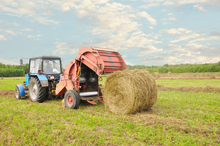With the approach of cooler weather, pastures are going dormant, and hay bales and haylage have been stored and are now beginning to be fed to horses. The threat of botulism contamination of hay and haylage is a seasonal concern for horse owners.

Contaminated hay as source of botulism in horses
Once botulism toxins enter the horse's system, the incubation period is from 24 hours to several days and the toxins reproduce repeatedly and rapidly in the gut of the animal soon blocking the connections between the nerves and the muscles.
The botulism bacterium is a spore-forming bacteria that grows in the absence of oxygen and is found world-wide. It is present in soil and in decaying animal carcasses.
Although it occurs less often in decaying plant material, hay can be contaminated during the raking and bailing process. Haylage with its higher moisture levels, a pH above 4.5 and anaerobic conditions provides ideal conditions for the growth of Clostridium botulism.
When the bacterium grows, it produces toxins that block the connection between the nerves and muscles. Affected horses often exhibit signs varying from muscle weakness to paralysis, and they eventually die when their respiratory muscles become paralyzed, or when other health problems arise from being down.
Although horse owners are urged to vaccinate their horses against botulism, only Type B vaccinations are licensed for use in horses. This means the vaccine protects horses for only one of the seven possible types of botulism.
Botulism is a disease that affects not only horses, but also a wide variety of animals including humans. It is closely related to the organism that causes tetanus, but is more deadly. Clostridium botulinum is always present in the environment. Eight distinct toxins of botulism have been identified.
Once the toxins enter the horse's system, the incubation period is from 24 hours to several days. Once within the system, the toxins reproduce repeatedly and rapidly in the gut of the animal. These toxins block the connection between the nerves and the muscles.
Reports of botulism in horses date back to the early 1980's in England and Australia. In recent years, outbreaks have been reported in the United States and Germany.
The ingestion of pre-formed toxins is the usual cause of infection in adult horses. This normally occurs when the animal eats bits of decayed or decaying material in their haylage, silage or hay. When hay is baled at about 45-50% moisture and wrapped in plastic or placed in a bag that reduces the presence of oxygen, it sets the stage for the development of Clostridium botulism.
Hay often becomes contaminated with the botulism bacterium during the raking and baling process. Rabbits, rodents and birds are killed during the mowing process and become incorporated in the hay. The smallest amount of decaying or decayed carcass may be distributed into many bags or bails and may not be detected because of the quantity and way of making the large bales or the haylage/silage.
A second common mode of contracting botulism by horses is through growth of the agent in the gastrointestinal system, also known as toxicoinfectious botulism. In cases where toxicoinfection is the route of the attack, the horse ingests spores that then germinate and produce toxins within the gastrointestinal tract.
Shaker Foal Syndrome is an example of this mode of contracting botulism. It occurs at approximately three to eight weeks of age, causing muscle tremors resulting in the name.
Wound infection is the third mode of contracting botulism. Although it is less common, toxins are produced at the site of the wound and absorbed into the horses system. Sometime seen in foals, the umbilical stump becomes infected and the toxins enter the system resulting in the classic symptoms of the disease.
The best methods of prevention include making sure that all horse feed is clean, harvested and prepared properly and are not allowed to become contaminated. Horse troughs and feed bins should be cleaned on a regular basis and water should be fresh each day to preclude becoming contaminated by rodents or bird droppings.
